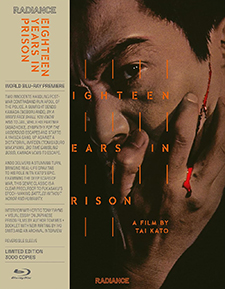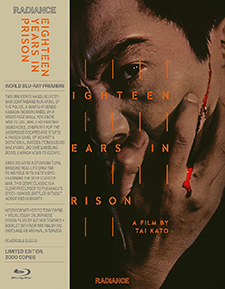Eighteen Years in Prison (Blu-ray Review)

Director
Tai KatôRelease Date(s)
1967 (July 30, 2024)Studio(s)
Toei Company (Radiance Films)- Film/Program Grade: B+
- Video Grade: B-
- Audio Grade: B-
- Extras Grade: C
Review
Tai Katō’s Eighteen Years in Prison (aka Choueki juhachi-nen) tells the story of Kawada (Noboru Andō), a former captain in the Japanese military who struggles to find his place in the aftermath of World War II. Along with his fellow ex-soldier Tsukada (Asao Koike), he creates an organization to care for the needs of people who lost family members in the war. To finance their activities during the lean years of the Allied occupation, he’s forced to turn to a life of crime by stealing from American ships. His desire to help Hisako (Hiroko Sakuramachi) results in him planning an even more daring raid, and he ends up being arrested and sentenced to eighteen years. He finds the prison system to be every bit as corrupt as the underworld of post-war Japan, but he still operates on his own moral code and gains the respect of his fellow prisoners. The exception is Hisako’s wild younger brother Suichi (Masaomi Kondo), who blames Kawada for the death of their older brother during the war. Meanwhile, on the outside, Tsukada has become a full-fledged yakuza who runs a trafficking ring that takes advantage of desperate women, Hisako included. That puts Kawada onto a collision course with his former comrade, and even the walls of the prison won’t stop him.
Eighteen Years in Prison may have borrowed its title from the 1947 autobiographical work by Tokuda Kyuichi and Yoshio Shiga, but it definitely doesn’t tell their story. If anything, the script by Ka Kazuo Kasahara and Shin Morita could have been based on Noboru Andō’s life instead. It isn’t, but he certainly brought his personal experiences to bear in the role of Kawada. During the war, he had volunteered for a Fukuryū unit that was trained to work underwater in diving suits while carrying explosives that they were supposed to attach to invading Allied ships—essentially, they were kamikaze frogmen. Most of them never saw action because the horrors of Hiroshima and Nagasaki ended the conflict without the need for an invasion. After the war, Andō started his own yakuza family and ended up serving six years in prison. He eventually became an actor because acting felt natural to him, and his performance in Eighteen Years in Prison has a gruff but understated nobility to it that suited the ninkyo eiga (“chivalry films”) genre that was Toei’s specialty until Kinji Fukasaku helped launch the jitsuroku eiga (“actual record films”) with the Battles Without Honor and Humanity series.
In some ways, Eighteen Years in Prison helps to bridge the gap between the two. Kawada’s code of honor definitely fits more into the ninkyo eiga category, but his actions are driven by his guilt over having sent so many men to their deaths during the war. (Suichi is something of a Jiminy Cricket for him in that regard.) As a result, he feels a deep-seated sense of giri to the families of service members regardless of whether or not he’s the one directly responsible for their losses. He may have resorted to stealing in order to fund their work, but it was out of necessity that was driven by the deprivations of post-war Japan. That’s one reason why he’s so personally offended by the corruptions of the penal system—it’s corruption for corruption’s sake with no clear goal other than profit. That’s also why Tsukuda’s ascension into the ranks of the yakuza bothers Kawada so deeply. Their original criminal gang had been formed to help needy families, but Tsukuda is now exploiting those people instead. The compromises due to necessity have turned into the excesses of unrestrained capitalism, and Kawada is willing to jeopardize his own potential parole in order to do what he can to put a stop to it.
Much of Noboru Andō’s career as a yakuza arguably fell more into Tsukuda’s experience than Kawada’s, but that’s what makes him so ideal for the latter role. He disbanded his own yakuza family after his release from prison, and that was due in no small part to the fact that he had met with the mother of one of his slain crew members. Andō was able to bring the gravity of that experience into his portrayal of Kawada. It was the perfect part for him to play, and the story was also perfect material for director Tai Katō’s understated visual style. (Literally so, since he favored low camera angles with the characters positioned at the bottom of the frame.) The stars aligned in the making of Eighteen Years in Prison, and so it’s one of the most memorable entries into the Japanese prison genre.
Cinematographer Osamu Furuya shot Eighteen Years in Prison on 35mm film using Toeiscope anamorphic lenses, framed at 2.35:1 for its theatrical release. Radiance Films describes this version as being “transferred in High-Definition by Toei Company Ltd. and supplied to Radiance Films as a High-Definition digital file.” In other words, Radiance once again had to use whatever Toei provided to them, so any deficiencies in this presentation lie at Toei’s doorstep. The source looks like it’s a later generation dupe element, possibly even a print. The optical work is particularly ugly in this case, so any shots featuring titles or transitions look quite rough. The surrounding material is much better, though still far from perfect. The contrast tends to be harsh, with little detail in the blacks, and there are defects like speckling and density fluctuations visible throughout. There’s also some distortion at the edges of the frame, but that’s an unavoidable artifact of the Toeiscope anamorphic lenses that Furuya used. Toei’s master may not offer the clarity of a scan from the original camera negative, but it does accurately reproduce the look of their theatrical prints, and any rough edges do seem appropriate for this kind of fare.
Audio is offered in Japanese 2.0 mono LPCM, with removable English subtitles. Like most Japanese genre productions from the era, the sound is compressed with no real dynamics other than being consistently loud. There’s a bit of background noise, and the dialogue does have some excessive sibilance. That said, it’s always clear and comprehensible.
The Radiance Films Limited Edition Blu-ray release of Eighteen Years in Prison includes a reversible insert with new artwork by Time Tomorrow on one side and the original theatrical artwork on the other. It also offers 24-page booklet that includes an essay by Tom Mes and a 2002 interview with Noboru Ando. The following extras are included in HD:
- Tony Rayns (24:17)
- Tall Escapes: The Japanese Prison Film (16:57)
- Trailer (3:04)
Author, film programmer, and Asian cinema expert Tony Rayns is on hand to help bring viewers up to speed on Eighteen Years in Prison and where it fits into Tai Katō’s filmography. Not much is known about his life prior to his starting work in the film industry, but Rayns traces his movement through Shochiku and Toei studios. Throughout his career, he frequently worked on the screenplays, but rarely took credit for it. Eighteen Years in Prison (more accurately translated from the Japanese as “sentenced to eighteen years in prison”) was his second film working with Noboru Andō, and whatever biographical details may be lacking about Katō, Andō more than makes up for it, so Rayns also covers the former gangster’s fascinating life in and out of film.
Tall Escapes is a visual essay on the history of the Japanese prison films, hosted by author and historian Tom Mes. Mes traces the genre back to its antecedents in the pre-war era and its eventual blossoming during the post-war era. It was a natural genre for Toei at that time, and they would develop it further throughout the Seventies. Mes also looks at some of the other actors and directors who made noteworthy contributions.
The extras may be light, but like other Radiance Films Blu-ray releases of Japanese genre films, they’re well worth the time. (Once again, this is a case where the relatively low C rating for the extras is just a reflection on their quantity, not their quality.) Both of these featurettes are an essential introduction to Eighteen Years in Prison and the historical context under which it was created. The video quality is limited by the master that Toei provided, but to the best of my knowledge the film has never been released on disc in English-speaking territories, so it’s fantastic that Radiance is offering it in both North American and the U.K. They’re providing an amazing spotlight for relatively overlooked international films that typically aren’t licensed by other distributors. It’s a highly recommended release just for its historical significance, let alone for the valuable context that the extras provide.
- Stephen Bjork
(You can follow Stephen on social media at these links: Twitter, Facebook, and Letterboxd).

